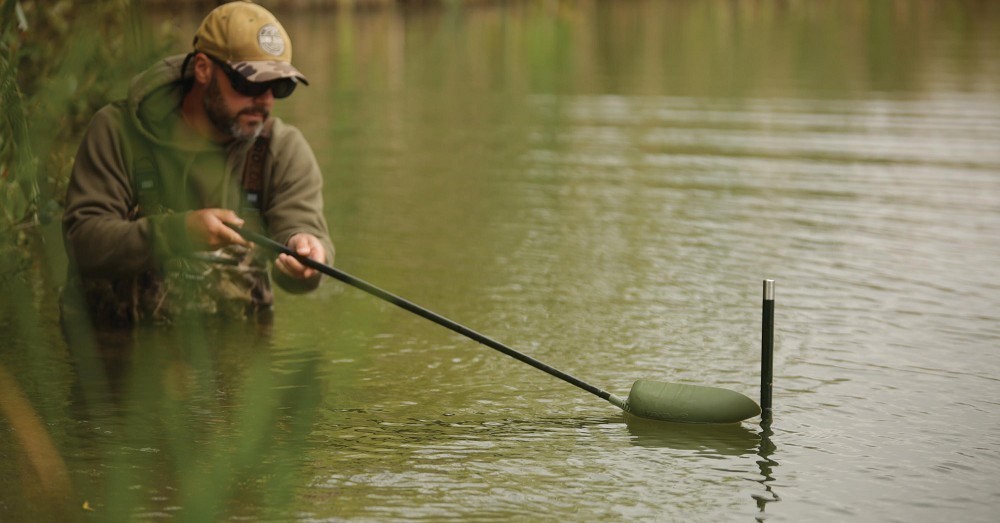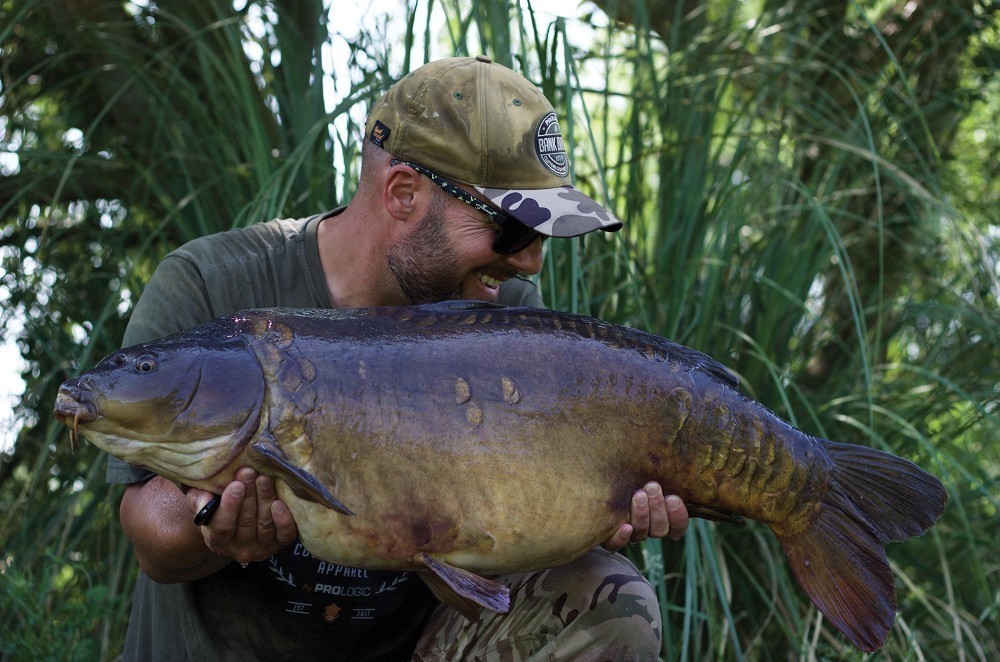
Adam Penning talks margin fishing
Proper margin fishing is one of the most under exploited forms of carp fishing yet remains one of the most exciting
Executed correctly, margin fishing can be one of the most effective, particularly at this time of year. If the water is clear and the margins are deep enough, being able to watch the carp feed is such a heart-pounding experience.
The right spot
There isn’t a lake where carp will not visit the margins. There may be instances where a large weedbed will be sat out in the middle, which is when the carp will spend most of their time in and around it. But other than that, the margins will always hold fish, even if they are passing by them regularly, they will patrol the edges daily.
I have found that if you have those slow, gradual margins that require you to wade out to net the fish, the carp won’t visit the margins so regularly. However, if you have a few feet then they will come in. The deeper it is, the more secure the fish will feel and that is when you will get numbers and the bigger fish coming in close.
When you are trying to find a margin spot, it is all about where you have seen fish. You have to bait or fish spots that receive a lot of traffic from the carp. There will be spots where the fish simply won’t visit for whatever reason, so try and pick an area that the fish visit or pass by regularly.
If you have zero visibility, it makes it a lot harder. In that instance, I would pick an area that receives a warm wind and study the lake in greater detail. Look for those disturbances on the surface, particularly bubbles or flat spots, both will give the game away. If the fish are showing 10yds out in the pond, slightly further out than your spot, you know the fish will be visiting it. They don’t tend to jump in the edge, unless you are fishing to a far margin or a set of snags or lilies.
Marginal features will often hold carp. If they are not there when you arrive, they will be sure to visit them at some point. As I mentioned, snags and lilies are great holding spots, so too are overhanging trees. These are great to fish to, but they can mislead you, the key is to look for fish and observe where they are patrolling and if possible, where they are feeding.
So let’s say that we have found a spot on a lake that has zero visibility. There has been quite a few instances where having a set of chest waders and a prodding stick are essential to finding spots in the margin. You can often feel with your feet and with the stick, it allows you to find the firm areas in which will indicate where the fish have fed. There was a spot that I fished not so long ago that you wouldn’t have found it any other way. It was a small hard spot amongst very thick snotty weed and the stick allowed me to locate it. The prodding stick also gives you bearings on how deep it is, preventing you from walking off the edge of the shelf, so is key to keeping you safe and dry.
The chest waders also allow you to walk down the margin and place rigs under overhanging trees. As long as the tree is safe and doesn’t come in to the water, it is safe to fish. You have to think outside the box and how many other people would have bothered getting in waders and walking down the margin, accurately placing a rig in maybe a spot that the fish have not been fished before?
Carp food
A baiting spoon is key to this for a number of reasons. Firstly it allows you to ship it out and under overhangs. You can also bait extremely accurately too, rather than throwing it in and spreading it everywhere. You can do some dapping with a spod, but a spoon is the most accurate and easy way of doing it.
I use a mixture of small and larger items, so throwing it will leave a trail out to the spot, with the smaller items falling short and the larger ones landing on the spot. The mix itself involves plenty of liquid, small items and broken boilies. I start off with some hemp and corn. I then add some washed-out Krill boilies that are very soft. I then squeeze them in my hand, creating slop, with loads of crumb and a few chunks. Boilie crumb is probably the best bait to use, with it being irresistible to carp. I add some of the Tuna Liquid to the final mix, which will add loads of smell and taste to the swim. It all looks like one big sloppy mess once it is together, and this is why the spoon is great, allowing you to introduce all those wonderful cloudy liquids to the swim and the carp are really attracted to it.
In terms of how much to bait up with, I don’t like to use too much. Little and often is key and if you can apply it regularly to the spot. If I am leaving and won’t be back for a few days, I like to give them a little bit more.
Clever tactics
Always be aware of the birdlife. If you can, make sure that the swans can’t reach it. If they can, try and do it discreetly without them seeing it. It seems obvious and logical, but I have seen so many people do it while the swans are just a few yards away. If they see you tipping in bait, they will be over to have a look. That is one of the advantages of baiting under overhanging trees: the swans cannot get there. The spoon is quiet and prevents that loud sound of bait hitting the water and attracting every bird in the lake.
I try and make sure that everything is totally pinned to the bottom. I use a heavy fluorocarbon main line and also add a few chunks of putty to totally ensure that those carp will not come in to contact with my line.
Using the ‘Washing Line Trick’ is a great way of fishing to a far bank, as it allows you to keep most of line out the water. The only section that comes in to contact with the lake is the last few feet, which you can lay and pin down nicely. To do this I cast to the far bank and then walk round with the rig. I then place the bait and make sure everything is pinned down nicely before clipping the line on to a strong-arm clip on the bankstick. When I get a bite, the line will pull out the clip and I reel in the slack and come in to contact with the carp.
End tackle
As far as rigs goes, the most effective rig arrangement that I have found is large, flat in-line leads and short hooklinks. I did find that this was out-fished by small leads and running rigs, but generally the in-line lead is a real winner. I think some people worry about how cumbersome a large lead is and obvious it can be on the bottom. Only last week I had a number of fish from a shallow margin spot and when I went to re-do the rig, I could see all my leads on the bottom. Carp don’t care about the lead, but one thing I do to give it that extra camouflage is mould some marginal clay or mud around it. One thing that I have found is by getting rid of the tubing or leadcore and going fluorocarbon straight through, it is much less visible and you do pick up more bites.
I use a short, stiff hooklink, almost like a combi rig with the end section with a supple braid. I combine this with a small balanced bait too, something like a trimmed Krill Wafter is ideal and sits perfectly and inconspicuously over the mix that I use. The smaller the hookbait is, the more bites you get in my opinion. I don’t know what it is but using big baits close in causes caution on most lakes, so going small will definitely help you catch more fish.
The short hooklink suits the mix that I use. The fish are hovering close to the bottom, not moving far between each mouthful, so I want something nice and short so that as soon as that bait is picked up, they feel the weight and impact of the large lead.
 A mirror just shy of 30lb, caught right from the edge applying the tactics explained in this feature
A mirror just shy of 30lb, caught right from the edge applying the tactics explained in this featureThe final approach
How you approach the spot is very important. It goes without saying that you need a good set of polaroid sunglasses to enable you to see beneath the surface glare. When you are walking up to the spot, dress in drab clothing and cover up as much as possible. When you walk, do it from heel to toe, and do it carefully too. Carp can sense vibrations more than anything and by thumping your boots along the bank, it will alert any fish in the area.
Ideally you want to try and resist watching the spot, but that would take the fun away. It is totally exhilarating and as long as you stay still and covered up, you can watch the fish feed and even take the hookbait, which is one of the most exciting aspects of angling.






